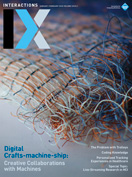Authors:
Martin Murer, Verena Fuchsberger, Alina Krischkowsky, Bernhard Maurer, Alexander Meschtscherjakov, Dorothé Smit, Manfred Tscheligi
How do you describe your lab to visitors? The Center for Human-Computer Interaction is an interdisciplinary research organization at the University of Salzburg. Our research integrates different approaches. Depending on the research objective, we employ empirical, theoretical, design-driven, or artistic ways of generating knowledge. Three years ago, the relocation of our lab allowed us to design our space from scratch in a way that specifically supports our diverse ways of working. This is reflected in three studios that constitute the core of our lab: Studio 1 is a space for recreation, discourse, and socializing, located at the very center of our upper-level office spaces. A slide connects it to Studio 2, which is a workshop that includes a variety of tools for prototyping (e.g., sewing machines, a 3D printer, electronics workstations) and loads of somewhat organized materials, as well as accumulated technology and gadgets from about 15 years of research projects. Finally, Studio 3 is our largest room, a space tailored to collaboration across disciplines and sectors. Studio 3 is more than a lab space for researchers: Here, we host artists in our atelier, invite speakers from various disciplines onto our stage, and generally build everything that sounds like a good idea.
 |
Studio 1 - a space for recreation and discussion. |
How many people are in the lab, and what is the mix of backgrounds and roles?
We are around 25 full-time researchers with various backgrounds, including social sciences, engineering, humanities, design (information, interaction, media, fashion), psychology, philosophy, architecture, and—yes—carpentry. Our center is directed by Manfred Tscheligi, a full professor in HCI. Furthermore, one associate professor, three post-docs, 16 Ph.D. students, and four junior researchers work in our lab, supported by five people in administration. Plus, we are almost constantly joined by resident artists, visiting researchers, or project partners to spice things up.
 |
Demo of "Beyond Cooperation" during ECSC. |
 |
A lot of our design research is material driven. |
 |
Our driving simulator is very modular and enables our researchers and students to study various aspects of human-computer interaction during (semi-autonomous) driving. |
 |
Some use the slide on a daily basis. |
 |
A prototype for a large-scale kinetic display. |
What is the one thing you see as most important about the work you do there? We love cooperation. There are of course cooperative research projects with national and international research and industry partners. More unique, though, is our close cooperation with partners from other sectors. For instance, we host an artist-in-residence program in collaboration with subnet, a platform for media arts and experimental technologies, and Studio 3 is home to regular artist talks. As part of the so-called Science and Technology Hub, we cooperate with collocated institutions: a community-driven FabLab, technology startups, a co-working space, and the university departments of computer science, chemistry and physics of materials, and geoinformatics. Together with those and other partners, we operate an extracurricular STEM program for juniors and regularly open our labs for related events. In most of our projects, we follow a human-centric approach and usually operate on long-term partnerships with, for example, a social housing company, which allows our research to have local impact in the communities we work with.
 |
A workshop at our whiteboard table. |
What is a unique feature of your lab? Our biggest collaborative space, Studio 3, features a 6x1.2-meter whiteboard table at its heart. This table can accommodate around 20 people working, drawing, taking notes, and making things together. More than we had anticipated, this horizontal whiteboard creates a collaborative atmosphere during, for example, stakeholder meetings, by providing equal access to and ownership of the shared canvas during note taking or the sketching of ideas. Furthermore, with a single press of a wireless button, a top-down picture of the whiteboard gets posted to our Slack workspace for future reference. Those pictures not only capture the notes that were taken but also all the objects lying around on the table, which later often serve as mental scaffolds when revisiting notes or scribbles.
 |
The lab extends to our patio and the adjacent public garden—lunch break during ECSCW. |
How would you describe how people interact in your lab? While we do have four research groups as organizational entities, pretty much everything in our lab is shared: Of course we share our thoughts and ideas, but we also share the workload, our tools and materials, our failures and successes. Our seven to 10 concurrent research projects often require different expertise at different stages of the project. A lot of the necessary exchange and support across project teams emerges en passant: for example, while having a daily joint lunch, during weekly team meetings with (often homemade) cake, in project meetings in open spaces, and during sundowners on our terrace. In general, a transparent space and culture fosters awareness for everyone's ideas and challenges.
 |
Electronics workshop during a STEM event. |
What is one feature of your lab that you want and do not have? While our lab provides a pleasurable environment for our researchers and collaborators, it is not yet suited to accommodate our growing number of master's students without compromising our existing routines and habits. For our recently founded master's program in HCI, we therefore aim to create equally equipped lab spaces, but tailored to the organizational and operational demands of learning and teaching.
Copyright held by authors
The Digital Library is published by the Association for Computing Machinery. Copyright © 2020 ACM, Inc.







Post Comment
No Comments Found